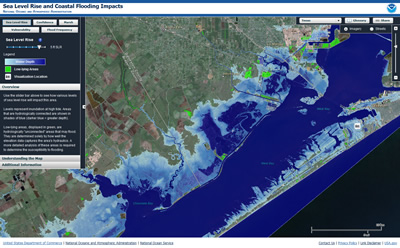
Three years ago today, Hurricane Sandy struck the east coast of the United States, directly causing 72 deaths, contributing to 45 others, and yielding nearly $50 billion in property losses. The hurricane knocked out power for 8.5 million people, and caused a massive storm surge in New York, Connecticut, and New Jersey that flooded subways and tunnels with caustic waters, damaged hundreds of thousands of homes and businesses, and triggered an electrical fire that burned 130 homes in Breezy Point, NJ to ash. Another large storm hit the affected region nine days later, causing additional damage and hampering recovery efforts.
Just weeks after the disaster, the White House established the Hurricane Sandy Rebuilding Task Force with a charge to help coordinate recovery efforts and to develop a long-term rebuilding plan. In developing its plan and recommendations, the Task Force sought to ensure that communities and infrastructure would be rebuilt to be more resilient and better prepared for the increasing risks posed by climate change. Noting that sound decisions about how to rebuild should be based on sound evidence and science, the Task Force created a Science Coordination Group, which we chaired.
The Task Force emphasized in its rebuilding strategy that science needs to be an integrated part of post-disaster response and recovery, both to support better decision-making and to develop new ways to reduce risks. Rather than a stand-alone section on science goals and priorities, the Science Coordination Group reviewed and contributed to all of the Task Force recommendations. Hence a number of the Task Force recommendations set both implicit and explicit goals for science and technology related to the major elements of the Rebuilding Strategy. In the three years since Hurricane Sandy hit, the progress made on these goals is impressive. The Federal government has developed a number of science-based products to make our nation better prepared for and more resilient to coastal storms and other natural disasters. These products include:
- Scientific research priorities for green infrastructure. Research has shown that nature and nature-based features can play significant roles in coastal resilience. The National Science and Technology Council has developed a set of priorities for Federal research to support the integration of coastal green infrastructure into risk reduction, resilience planning, and decision making. Their report on this topic also serves as a useful reference for planners and decision makers because it provides an introduction to major categories of coastal green infrastructure and associated ecosystem services and the factors that can affect their viability. The report can be accessed here.
- Improved data-sharing among federal, state, and local officials. The work of the Task Force led to the launch of disasters.data.gov, a public resource that fosters collaboration around and the continual improvement of disaster-related open data, free tools, and ways to empower first responders, survivors, and government officials with the information they need in the wake of a disaster. The site also serves as a portal to citizen science and crowdsourcing activities for disaster response and preparedness.
- Visualization of the impacts of sea-level rise. The Sea-Level Rise Viewer, developed by the National Oceanic and Atmospheric Administration, is a publicly available, easy-to-use tool that was developed to help planners better assess risks from sea-level rise. Users can select a geographic area and use a slider bar to simulate various sea-level rise scenarios and the corresponding areas that would be impacted by flooding. The tool also provides images that depict how local landmarks could be affected, and additional information about marsh impacts, nuisance flooding, and social and economic impacts.

Integrating science and scientists into planning and decision making for risk and disaster management has become the new normal for Federal government. This is part of Sandy’s legacy. We look forward to increasing collaboration between scientists and planners, additional relevant findings and science-based tools to enable informed decision making, and, ultimately, a better prepared and more resilient nation.
Tamara Dickinson is Principal Assistant Director for Environment and Energy at the White House Office of Science and Technology Policy.
Kevin V. Werner is Regional Climate Services Director, Western Region, at the National Oceanographic and Atmospheric Administration.

